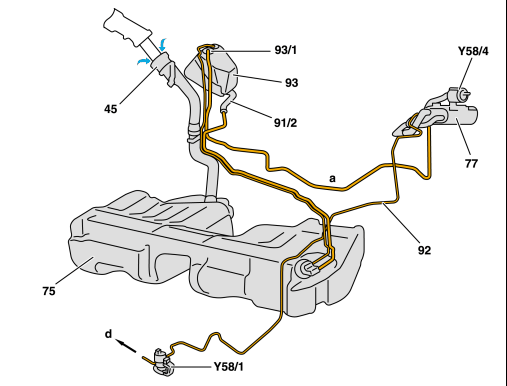The legislator demands:
 Refueling gases in the vehicle must be collected (ORVR = Onboard Refueling Vapor Recovery). Refueling gases in the vehicle must be collected (ORVR = Onboard Refueling Vapor Recovery).

Fuel and refueling gases must be separated in order to prevent fuel from flowing into the activated charcoal canister due to inappropriate refueling or a defective nozzle.
The filler neck (45) is designed as a suction jet pump.
The fuel out of the nozzle accelerates through this in the filler neck and air is suctioned around the nozzle.
As a result of this air intake around the nozzle, the refueling vapors are not able to rise up at the filler neck and escape to atmosphere.
The refueling gases are stored in the activated charcoal canister (77) and when releasing regeneration together with fuel gases out of the fuel evaporation control system, are suctioned off and burnt by engine.
If fuel flows to the high mounted safety valves (75/1), they close the vent line to the activated charcoal canister. Through powerful braking, accelerating or cornering the valves can also close briefly. |
|
Model 202, 203, 208, 209, 211
The refueling vapors flow along the vent line (91/2) to the expansion reservoir and on from there to the activatetd charcoal canister.
Model 170, 210.0, 215, 220, 230, 240
In the fuel tank (75), two safety valves
(rollover valves) are mounted.
If the fuel tank is full, the float with the flap (45/2) closes the filler neck at the bottom. This ensures that the refueling nozzle shuts off more rapidly and overfilling is largely prevented. A check valve (45/1) prevents the quick increase of fuel in the filler neck. If an excessively high pressure exists in the activated charcoal canister, the pressure relief valve (77/1) opens. In this special case the removal of pressure is performed via the activated charcoal canister shutoff valve (Y58/4) into the open air.

Ending refueling when the refueling nozzle switches off (and the fuel tank is full)! On no account overfilling fuel tank as a result of refueling nozzle being switched on several times. |



 Refueling gases in the vehicle must be collected (ORVR = Onboard Refueling Vapor Recovery).
Refueling gases in the vehicle must be collected (ORVR = Onboard Refueling Vapor Recovery).
